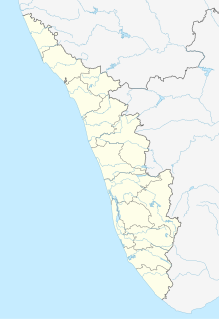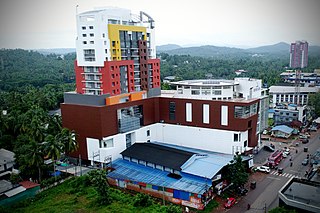
Thrissur, formerly Trichur, also known by its historical name Thrissivaperur, is a city and the headquarters of the Thrissur district in Kerala, India. It is the third largest city in Kerala after Kochi and Kozhikode, and the 21st largest in India. It is famous for the Thrissur Pooram festival.

Malappuram is one of the 14 districts in the Indian state of Kerala, with a coastline of 70 km (43 mi). It is the most populous district of Kerala, which is home to around 13% of the total population of the state. The district was formed on 16 June 1969, spanning an area of about 3,554 km2 (1,372 sq mi). It is the third-largest district of Kerala by area, as well as the largest district in the state bounded by Western Ghats and Arabian Sea to the two sides. Malappuram is the third major contributing district to the Gross State Domestic Product of Kerala as of 2019, after Ernakulam and Thiruvananthapuram. The district is divided into seven Taluks - Eranad, Kondotty, Nilambur, Perinthalmanna, Ponnani, Tirur, and Tirurangadi. Economically booming towns in Malappuram district include Malappuram, Manjeri, Perinthalmanna, Kottakkal, Nilambur, Tirur, Parappanangadi, Kondotty, Chemmad, Puthanathani, Valanchery, and Edappal.

Palakkad District, in the southeastern part of the former Malabar district, is one of the 14 districts of the South Indian state of Kerala. It is located right in the middle of the state. Also, it is the largest district in Kerala since 2006. The city of Palakkad is the district headquarters. Palakkad is bordered on the northwest by the Malappuram District, on the southwest by the Thrissur District, on the northeast by Nilgiris District, and on the east by Coimbatore district of Tamil Nadu. The district is nicknamed "the granary of Kerala". Palakkad is the gateway to Kerala due to the presence of the Palakkad Gap, in the Western Ghats. A significant Tamil-speaking population resides in the eastern area of Palakkad district. The total area of the district is 4,480 km2 (1,730 sq mi) which is 11.5% of the state's area which makes it the largest district of Kerala. Out of the total area of 4,480 km2 (1,730 sq mi), about 1,360 km2 (530 sq mi) of land is covered by forests. Most parts of the district fall in the midland region, except the Nelliampathy-Parambikulam area in the Chittur taluk in the south and Attappadi-Malampuzha area in the north, which are hilly and fall in the highland region.

Palakkad Gap or Palghat Gap is a low mountain pass in the Western Ghats between Coimbatore in Tamil Nadu and Palakkad in Kerala. It has an average elevation of 140 metres (460 ft) with a width of 24–30 kilometres (15–19 mi). The pass is located between the Nilgiri Hills to the north and Anaimalai Hills to the south.

Agumbe is a settlement situated in the Thirthahalli taluka of Shimoga district, Karnataka, India. It is nestled in the thickly forested Malenadu region of the Western Ghats mountain range. Owing to its high rainfall, it has received the epithet of "The Cherrapunji of South India", after Cherrapunji, one of the rainiest places in India.

Kerala is situated between the Arabian Sea to the west and the Western Ghats to the east. Kerala's coast runs some 580 km in length, while the state itself varies between 35–120 km in width. Geographically, Kerala roughly divides into three climatically distinct regions. These include the eastern highlands, the central midlands, and the western lowlands. Located at the extreme southern tip of the Indian subcontinent, Kerala lies near the center of the Indian tectonic plate ; as such most of the state is subject to comparatively little seismic or volcanic activity. Geologically, pre-Cambrian and Pleistocene formations comprise the bulk of Kerala's terrain. The topography consists of a hot and wet coastal plain gradually rising in elevation to the high hills and mountains of the Western Ghats. Kerala lies between northern latitude of 8°.17'.30" N and 12°. 47'.40" N and east longitudes 74°.27'.47" E and 77°.37'.12" E. Kerala's climate is mainly wet and maritime tropical, heavily influenced by the seasonal heavy rains brought up by the monsoon.

Palakkadpronunciation (help·info), also known as Palghat, is a city and municipality in the state of Kerala in India. It is spread over an area of 26.60 square kilometres (10.27 sq mi). It is the administrative headquarters of the Palakkad District. The city is situated about 350 kilometres (220 mi) north of state capital Thiruvananthapuram, 50 kilometres (31 mi) southwest of Coimbatore in Tamil Nadu, and 66 kilometres (41 mi) northeast of Thrissur on the Salem-Kochi National Highway NH 544. Palakkad is also known as the rice bowl of Kerala. The 18th-century Palakkad Fort has sturdy battlements, a moat, and a Hanuman temple on its grounds. North on the Kalpathy River, the 15th-century Viswanatha Swamy Temple is the main venue of the Ratholsavam chariot festival. Northeast, near Malampuzha Dam, the town of Malampuzha has a rock garden created from recycled materials.

Thrissur is a district of Kerala situated in the central part of that state. Spanning an area of about 3,032 km2 (1,171 sq mi), Thrissur district is home to over 9% of Kerala's population.

Ernakulampronunciation (help·info), is a portion of the city of Kochi in central Kerala, India and has lent its name to the Ernakulam district. The Kerala High Court, the office of the Kochi Municipal Corporation and the Cochin Stock Exchange are situated here. Ernakulam is known as the commercial capital of Kerala. The Ernakulam Junction is a major railway station of the Indian Railways. Initially, Ernakulam was the headquarters of the Ernakulam District but was later shifted to Kakkanad. Ernakulam was once the capital of the Kingdom of Cochin. It is located 220 kilometres (137 mi) north - west of the state capital Thiruvananthapuram. The city has served as an incubator for many Malayali entrepreneurs and is a major financial and commercial hub of Kerala.

Kochi is a city in the Indian state of Kerala. Kochi is located in the district of Ernakulam. Old Kochi loosely refers to a group of islands including Willingdon Island, Fort Kochi, Mattancherry and Mundamveli In Mundamveli there is an Ancient Portugal Significant church named St.Louis church and the Biggest celebration of this church is related to the feast of St.Jacob which is celebrate every year on 30 December. Lakh of people even from different parts of India. Today Kochi includes Ernakulam, old parts of Kochi, Kumbalangi, and outlying islands. For many centuries up to and during the British Raj, the city of Kochi was the seat of the eponymous princely state — the Kingdom of Cochin, which lay between 9.48° and 10.50° latitude and 76.5° and 76.58° E longitude.

Murbad is a census town within the administrative division (taluka) of Thane district in the Indian state of Maharashtra. Murbad city with its neighbouring villages jointly form the Murbad nagar panchayat, which is near the cities of Thane, Karjat and Kalyan. Nearby cities include Badlapur, Ambernath, Ulhasnagar, and Dombivli. It is a largely industrial town with private and public enterprises (MIDC).

Koottanad is a town in Nagalassery Panchayath of Pattambi taluk of Palakkad district, in the state of Kerala. It is situated at the border of Thrissur, Palakkad and Malapuram districts. It is located 32 km from the Thrissur and 65 km from Palakkad, on the road between Guruvayoor and Palakkad. It is connected by road to other parts of Kerala and the nearest Railway station is Pattambi 9 km away. Bharathapuzha Nila Riverflows through Thrithala, 5 km away. The Pakkanar Memorial, a tribute to the Pariah saint of Parayi petta panthirukulam can be found at Thrithala. The Kattil Madam Temple, a small granite Buddhist monument on the Pattambi-Guruvayoor road, is of great archaeological importance. It is believed to date back to the 9th/10th century AD. The debris of a Fort can be seen behind Juma Mazjid, Koottanad between Koottanad and Chalissery Road.

The Geography of South India comprises the diverse topological and climatic patterns of South India. South India is a peninsula in the shape of a vast inverted triangle, bounded on the west by the Arabian Sea, on the east by the Bay of Bengal and on the north by the Vindhya and Satpura ranges. Technically all Indian territories below the 20th Parallel.

Vilangan Hills is a hillock located in Adat Panchayat, near Thrissur city of Kerala state in India. The hill gives a panoramic view of Thrissur city and Thrissur Kole Wetlands from the top. The hill was referred as a Oxygen Jar of Thrissur city. The name 'Vilangan Kunnu' is a misnomer because 'Vilangan' itself means hill. There is no need of adding 'Kunnu' after 'Vilangan'. It is an ancient Malayalam word derived from proto-Dravidian language. Till the 1970s the word 'Kunnu' was not used by revenue authorities and locals. It is a recent addition. In Tamil too 'Vilangan' means hill.
Mezhathur is an Indian village in the state of Kerala situated at Pattambi taluk of Palakkad district at the border of Thrissur, Malappuram and Palakkad districts. It is a historical and cultural village in Kerala. It is known for traditional Ayurveda physicians like Chatharu Nair and Vaidyamadom Valiya Narayanan Namboodiri. It is also the native place of renowned writer and social reformer V. T. Bhattathiripad.

The Indian city of Thiruvananthapuram is located in Thiruvananthapuram district in the state of Kerala. The city is located at 8.5°N 76.9°E on the west coast, near the southern tip of mainland India. The city situated on the west coast of India, and is bounded by Arabian Sea to its west and the Western Ghats to its east. The city and the suburbs spans an area of 250 km2 (96.53 sq mi). The average elevation of the city is 16 ft above sea level. The highest point within the city limits is the observatory. Agastya Mala, which has an elevation of 1,868 metres (6,129 ft) is only about 60 km from the city. The Ponmudi hill station which has an elevation of 1,100 metres (3,609 ft) is also near the city.

The Malabar Coast is a region of the southwestern shoreline of the mainland Indian subcontinent. Geographically, it comprises the wettest regions of southern India, as the Western Ghats intercept the moisture-laden monsoon rains, especially on their westward-facing mountain slopes. Culturally, it covers the northern part of the Kerala state along with Tulu Nadu and Kodagu district, from the Arabian Sea inland to the Western Ghats. The term is sometimes used to refer to the entire Indian coast from the western coast of Konkan to the tip of the subcontinent at Kanyakumari.

Thrissur Kole Wetlands is a wetland lying in Thrissur District in Kerala, India. It gives 40 per cent of the Kerala’s rice requirement and acts as a natural drainage system for Thrissur city and Thrissur District. The Kole Wetlands is one of largest, highly productive and threatened wetlands in Kerala and it comes in Central Asian Flyway of migratory birds. [[File:Journey of bhagavathi.jpg|thumb|right|Kole Wetlands in [[Puzhakkal,Enamavu], Thrissur City]]

City of Kollam or Quilon is a Port city in South India and was the commercial capital of erstwhile Kingdom of Travancore. It is situated on the Laccadive Sea coast of South Kerala. The city is known as the "Gateway to the backwaters of Kerala". The city lies on the banks of Ashtamudi Lake, Kerala's second largest lake, on the Arabian sea coast. Major parts of Kollam city are covered by Ashtamudi Lake.

Malakka (മലാക്ക) is a village in Thrissur district of Kerala, India. It is located in Thekkumkara GramaPanchayath.





















